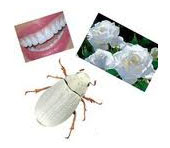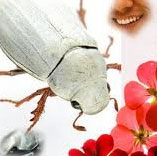 Every animal has many characteristics of creation that amaze people. While some have the most ideal shape (hydrodynamic) to move on water, others satisfy needs such as hunting and defense which are very different to us. Most of these are characteristics people face for the first time, or more honestly, characteristics they have just realized. There is no doubt that products that came about by imitating these extraordinary structures we have discovered thanks to bio-mimetics, will be used very often in our future lives. One of the wonders of creation discovered through science is the insect called “Cyphochilus” with its white shell, showing the way to scientists about bleaching techniques.
Every animal has many characteristics of creation that amaze people. While some have the most ideal shape (hydrodynamic) to move on water, others satisfy needs such as hunting and defense which are very different to us. Most of these are characteristics people face for the first time, or more honestly, characteristics they have just realized. There is no doubt that products that came about by imitating these extraordinary structures we have discovered thanks to bio-mimetics, will be used very often in our future lives. One of the wonders of creation discovered through science is the insect called “Cyphochilus” with its white shell, showing the way to scientists about bleaching techniques.
More successful bleaching techniques for many products from textile to the cleaning industry, from metal to the paper industry, and even in the field of dentistry are being developed. Scientists also benefit from nature on this subject. The shell of the insect called “Cypho-chilus” that lives in Southeast Asia is the last part in this research. The formation of the white color of this insect’s shell is being examined by the academic circles of the University of Exeter.
Scientific American magazine, announced the white color of the Cyphochilus insect, a color not attained by any technological method ever, in these words:
“Forget the bleaching methods. This insect can be the key to whites who are even whiter. After this, the expression of “as white as the Cyphochilus insect” can be used.”
The Shell of “Cyphochilus” Whiter Than Milk and Human Teeth
The Cyphochilus insect has a white shell with a rare radiance. According to Imerys Minerals Ltd. team, this insect is a living creature, which can lead the way to technology of how to make ultra thin white substances. According to the degrees of whiteness and radiance accepted by ISO standards, this insect is much whiter than milk and human teeth. In addition, both structures are much thicker in comparison to the insect’s shell structure. Dr. Pete Vukusic, from the Physics Division of the University of Exeter, says the following about Cyphochilus:
“Such form of whiteness in such thinness is found very rarely in nature. The moment I have seen it, something told me that there is something special about this insect. If what we learn from this insect is transferred to technological design ideas, in the future, the paper we write on, the color of our teeth and even the new generation white products will develop considerably.”
How Is a Sharp White Color Obtained?
Colors are formed through pigmentation or the orderly arrangement of the layers. The color of a matter is the electromagnetic rays in the visible region reaching from that matter to our eyes. However, whiteness is a structure without rules that forms with the simultaneous dispersion of all colors. Electromagnetic ray passes through transparent matters but it is reflected on non-transparent matters. If these rays cover all of the rays in the visible region then transparent matters appear as colorless and non-transparent matters appear as white.
Dr. Vukusic examined the body, head and legs of the insect using an imaging system with his electron microscope. What he found is that the insect is covered with long horizontal scales and that these scales have a three-dimensional inner assembly with a cellular net structure made up of completely disordered protein fibres. This inner structure is the key to the unique and effective dispersion of all wave lengths. This characteristic is a must for a sharp white color. With the balancing of the sizes of structures by leaving spaces in between them, a far more effective dispersion of light than that of white paper and tooth enamel is achieved. The optic nerve specialist Pete Vukusic said “This is one of my favourite examples of intelligence in nature” for this characteristic of the insect.
How Could a Substance Even Whiter Than Enamel on a Baby’s Tooth Be So Thin?
 Science circles have found it very surprising and unique that an object of such an overwhelming radiance and whiteness has such a thin structure. This is because industrial products need to be thickened in order for them to be white. For example, industrial mineral coverings used in high quality paper and some dyes are thickened twice their size to be bleached.
Science circles have found it very surprising and unique that an object of such an overwhelming radiance and whiteness has such a thin structure. This is because industrial products need to be thickened in order for them to be white. For example, industrial mineral coverings used in high quality paper and some dyes are thickened twice their size to be bleached.
The more layers a matter has, the more light it can emit and the brighter its color becomes. Vikusic and his co-workers have found that the scales of this insect are five micrometers thick and even whiter than enamel on a baby tooth. This perfect whiteness is a result of a surface with this special structure. The scales of this surface is one in 200 of a millimeter thick and are ten times thinner than human hair. The electron microscope has revealed that the scales of this insect are made up of complicated and disorderly distributed fibers and that every one of them is 250 nanometers (one in one billion of a meter) wide. This unstructured microscobic order distributes all wavelengths of the light equally to the surface and so plays a key role in obtaining white color. Dr. Pete Vukusic made the following comment on this superior feature which technology was not yet able to grasp:
“When I placed it under the electron microscope, it was like another world has opened. It was an extraordinary situation.”
Mimicking Nature Develops Technology Rapidly
Living beings created by Allah have possessed the many structures people cannot reach due to their lack of knowledge, for millions of years, meaning since the first moment they were created. As it is seen in this white insect, all beings have perfect features. Scientists are now looking at examples in nature for intelligent materials or intelligent solutions, for the projects they are trying to develop. Every feature they discover is amazing. This is because it is seen that living beings which have no knowledge of chemistry, which do not know any mathematics and which are sometimes smaller than fingertips possess systems more superior than those of laboratories where advanced technology is employed by scientists who were trained for years. Scientists make many technological improvements by imitating the creatures in nature.
The Owner of the unique structures in nature is Allah. Every person of intelligence and a conscious would see the reflections of Allah’s unique intelligence, infinite power and knowledge in the Creation of living beings between the skies and the earth.
A person who can think in a reasonable way would see the countless wonder of Creation around and understand that all of these are products of a common Intelligence. A person who can think would not admire an insect, a bird or a plant because of the superiority it possesses but admires Allah Who created it. Allah reveals as follows in one verse:
Those who remember Allah, standing, sitting and lying on their sides, and reflect on the creation of the heavens and the earth: ‘Our Lord, You have not created this for nothing. Glory be to You! So safeguard us from the punishment of the Fire. (Surah Al ‘Imran, 191)
Other Examples of Biomimetic Studies Common Today
Polar Birds That Use “Opposite Flow Heat Modifiers”
Generally, the feet of birds that dwell in cold climates are either inside cold water or on ice. Despite this, it is not a matter of discussion that the feet of these animals freeze, because they all have a circulatory system that minimize the heat loss. In these birds, warm and cold blood run through separate veins. However, these veins are very close to one another. Warm blood that flows downwards warms the cold blood that rises up. This, at the same time, decreases the shocking effect that occur due to the blood returning to the body being very cold. This natural heat modifying system called “opposite flow” is the same as the system used in the machines. (Wild Technology, Phil Gates p.65)
Engineers name such systems as “opposite overflow heat modifiers.” In these systems, two fluids (liquid or gas) separate from one another but in adjacent channels flow opposite to one another. If one fluid in a channel is hotter than the one in the other channel, heat passes from hot fluid to cold fluid.
“Signboards That Change on Their Own” Inspired From Bird Feathers
The association of the keratin protein and the natural dying substance called melanin in bird feathers ensures light to be refracted in the way we can see it. The light and dark colors we see on feathers is a result of this ceratin protein not being placed in a single direction. These very lively colors on bird feathers are an outcome of this structural characteristic of the feathers.
A Japanese firm inspired by these characteristics, manufactured re-usable signboards. The surfaces of these signboards change under the UV lights. The UV lights that fall on the signboard change the crystallized ordering of the substance and ensure that certain colors are off to show the message in question. These signboards can be used over and over again, or makes it possible for new images to be printed on it. In this way, both the cost of manufacturing new signboards and the need to use poisonous dyes for this production are avoided.
Fiberglass Technique on the Alligator’s Skin
Fiberglass technique has begun to be used in technology in the 20th century. However, this substance has existed in living beings since the first day they were created. For instance, the alligator’s skin is made up of the same substance as fiberglass.
Scientists did not know why the alligator skin, which cannot be pierced by arrow, knife or even bullets, was so strong until quite recently. However, the researches about this subject, have provided very interesting results: There is a special tissue on the back skin of the alligator. The substance, which gives endurance to this tissue, is the collagen protein fibers used inside. The specialty of these fibers is that they are added inside the tissues to strengthen the structure of the tissue. No doubt, this substance (collagen) has not acquired so many details and features as a result of coincidences that follow one another over the course of long years, as claimed by evolutionists. On the contrary, it was created with its perfect features by Allah, since it has first appeared on earth.
There is a special tissue on the back skin of the alligator. The substance, which gives endurance to this tissue, is the collagen protein fibers used inside. The specialty of these fibers is that they are added inside the tissues to strengthen the structure of the tissue. No doubt, this substance (collagen) has not acquired so many details and features as a result of coincidences that follow one another over the course of long years, as claimed by evolutionists. On the contrary, it was created with its perfect features by Allah, since it has first appeared on earth.


